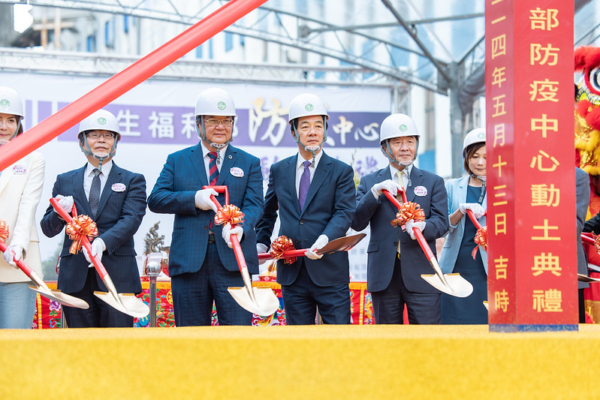The President of the Republic of China, Lai Ching-te, attended the groundbreaking ceremony for the construction of the Ministry of Health and Welfare’s Epidemic Prevention Center on the 13th. He expressed his hope to enhance Taiwan’s epidemic prevention resilience with higher standards and safeguard the health of the people. He also looks forward to the National Epidemic Prevention Center combining international cross-domain thinking, strengthening exchange and cooperation with other countries, and facing the challenges of the next emerging epidemic.
The Taiwan Centers for Disease Control (CDC) stated on the 13th that the domestic COVID-19 epidemic is on the rise, with 9,978 visits to emergency departments from May 4th to 10th. CDC spokesman Luo Yijun said the epidemic has been rising for five consecutive weeks, with the peak expected to occur in June this year.
President of the Republic of China, Lai Qingde, attended the “Ministry of Health and Welfare Epidemic Prevention Center Groundbreaking Ceremony” on the afternoon of the 13th, with attendees including Executive Yuan Minister without Portfolio Chen Shizhong, Minister of Health and Welfare Qiu Taiyuan, Legislators Wang Zhengxu and Chen Jinghui, Deputy Minister of the National Development Council Peng Li Pei, Deputy Minister of Health and Welfare Zhou Zhihao, Deputy Minister of the Interior Wu Tang’an, Vice President of the Academia Sinica Tang Tang, and Commander of the Infectious Disease Prevention and Control Medical Network Zhang Shangchun.
During his speech, Lai Qingde stated that the day marked an important moment in Taiwan’s epidemic prevention history, as they collectively witnessed the official groundbreaking of the “Ministry of Health and Welfare Epidemic Prevention Center,” ushering in a new era of safeguarding the health of the people.
Lai Qingde emphasized that epidemic prevention is akin to warfare. He pointed out that during the epidemic, frontline epidemic prevention personnel worked tirelessly to safeguard the health of the people, and each of them deserves a medal on their shoulders. However, without a brain to take the lead, strategize, and coordinate – namely the Epidemic Prevention Command Center to command, coordinate, and deploy nationwide epidemic prevention personnel and resources – even the strongest warriors would not be able to achieve efficient epidemic prevention results.
Reflecting on the past 20 years, Lai Qingde said Taiwan has experienced major epidemic challenges such as SARS, dengue fever, COVID-19, etc. He emphasized that every experience of responding to emergencies has taught them that epidemic prevention must be adequately prepared in peacetime to respond rapidly in times of crisis. In other words, epidemic prevention cannot be a last-minute effort.
After the SARS epidemic, Lai Qingde, who was a legislator at the time, collaborated with other legislators and government departments to amend the Infectious Disease Control Law, establish a central epidemic command center, upgrade the Centers for Disease Control to the CDC, increase the number of epidemic prevention physicians, establish nearly 3,000 negative pressure isolation beds or dedicated beds in hospitals nationwide, enhance material preparation, and promote international cooperation.
These preparations have provided Taiwan with greater epidemic prevention capacity to respond to the challenges of the COVID-19 epidemic. Lai Qingde stressed the need for continuous improvement with higher standards of epidemic prevention readiness to address the potential next phase of the epidemic, leading to the establishment of the National Epidemic Prevention Center to safeguard the health of the people.
To address the challenges of the post-epidemic era and promote public health, Lai Qingde mentioned that the Presidential Office established the “Healthy Taiwan Promotion Committee” last year to align with the international sustainable development goals for health. He hopes that the Ministry of Health and Welfare Epidemic Prevention Center can integrate international standards and cross-domain thinking, strengthen exchange and cooperation with other countries, and actively enhance Taiwan’s epidemic prevention resilience.
Lai Qinde mentioned that in the future, in addition to the epidemic command center, there will be a national-level laboratory, along with preserving the original historical buildings. The new Epidemic Prevention Center will not only be a significant step towards realizing a Healthy Taiwan but also a key milestone in enhancing Taiwan’s epidemic prevention system resilience. Additionally, because it is designed with the concept of circular economy, it will also serve as a benchmark project for promoting the transition to net zero.

